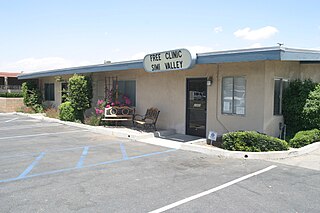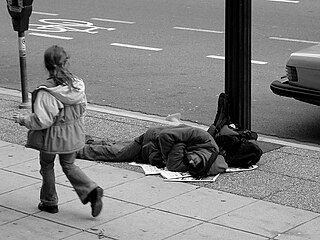Related Research Articles

The Downtown Eastside (DTES) is a neighbourhood in Vancouver, British Columbia, Canada. One of the city's oldest neighbourhoods, the DTES is the site of a complex set of social issues, including disproportionately high levels of drug use, homelessness, poverty, crime, mental illness and sex work. It is also known for its strong community resilience, history of social activism, and artistic contributions.

In the United States, the number of homeless people on a given night in January 2023 was more than 650,000 according to the Department of Housing and Urban Development. Homelessness has increased in recent years, in large part due to an increasingly severe housing shortage and rising home prices in the United States.

A free clinic or walk in clinic is a health care facility in the United States offering services to economically disadvantaged individuals for free or at a nominal cost. The need for such a clinic arises in societies where there is no universal healthcare, and therefore a social safety net has arisen in its place. Core staff members may hold full-time paid positions, however, most of the staff a patient will encounter are volunteers drawn from the local medical community.
Developmental disability is a diverse group of chronic conditions, comprising mental or physical impairments that arise before adulthood. Developmental disabilities cause individuals living with them many difficulties in certain areas of life, especially in "language, mobility, learning, self-help, and independent living". Developmental disabilities can be detected early on and persist throughout an individual's lifespan. Developmental disability that affects all areas of a child's development is sometimes referred to as global developmental delay.

Out of 10,000 female individuals 13 are homeless. Although studies reflect that there are many differences among women suffering homelessness and there is no universal experience, the average homeless woman is 35 years old, has children, is a member of a minority community, and has experienced homelessness more than once in their lifetime.
Housing First is a policy that offers unconditional, permanent housing as quickly as possible to homeless people, and other supportive services afterward. It was first discussed in the 1990s, and in the following decades became government policy in certain locations within the Western world. There is a substantial base of evidence showing that Housing First is both an effective solution to homelessness and a form of cost savings, as it also reduces the use of public services like hospitals, jails, and emergency shelters. Cities like Helsinki and Vienna in Europe have seen dramatic reductions in homelessness due to the adaptation of Housing First policies, as have the North American cities Columbus, Ohio, Salt Lake City, Utah, and Medicine Hat, Alberta.
Services for mental health disorders provide treatment, support, or advocacy to people who have psychiatric illnesses. These may include medical, behavioral, social, and legal services.

Homelessness or houselessness – also known as a state of being unhoused or unsheltered – is the condition of lacking stable, safe, and functional housing. The general category includes disparate situations, such as living on the streets, moving between temporary accommodation such as family or friends, living in boarding houses with no security of tenure, and people who leave their domiciles because of civil conflict and are refugees within their country.

Discrimination against homeless people is the act of treating homeless people or people perceived to be homeless unfavorably. As with most types of discrimination, it can manifest in numerous forms.

Anti-homelessness legislation can take two forms: legislation that aims to help and re-house homeless people; and legislation that is intended to send homeless people to homeless shelters compulsorily, or to criminalize homelessness and begging.
Care Programme Approach (CPA) in the United Kingdom is a system of delivering community mental health services to individuals diagnosed with a mental illness. It was introduced in England in 1991 and by 1996 become a key component of the mental health system in England. The approach requires that health and social services assess need, provided a written care plan, allocate a care coordinator, and then regularly review the plan with key stakeholders, in keeping with the National Health Service and Community Care Act 1990.

Outreach is the activity of providing services to any population that might not otherwise have access to those services. A key component of outreach is that the group providing it is not stationary, but mobile; in other words, it involves meeting someone in need of an outreach service at the location where they are. Compared with traditional service providers, outreach services are provided closer to where people may reside, efforts are very often voluntary, and have fewer, if any, enforceable obligations. In addition to delivering services, outreach has an educational role, raising the awareness of existing services. It includes identification of under-served populations and service referral and the use of outreach tools like leaflets, newsletters, advertising stalls and displays, and dedicated events. Outreach is often meant to fill in the gap in the services provided by mainstream services, and is often carried out by non-profit, nongovernmental organizations.

In a study in Western societies, homeless people have a higher prevalence of mental illness when compared to the general population. They also are more likely to suffer from alcoholism and drug dependency. It is estimated that 20–25% of homeless people, compared with 6% of the non-homeless, have severe mental illness. Others estimate that up to one-third of the homeless have a mental illness. In January 2015, the most extensive survey ever undertaken found 564,708 people were homeless on a given night in the United States. Depending on the age group in question and how homelessness is defined, the consensus estimate as of 2014 was that, at minimum, 25% of the American homeless—140,000 individuals—were seriously mentally ill at any given point in time. 45% percent of the homeless—250,000 individuals—had any mental illness. More would be labeled homeless if these were annual counts rather than point-in-time counts. Being chronically homeless also means that people with mental illnesses are more likely to experience catastrophic health crises requiring medical intervention or resulting in institutionalization within the criminal justice system. Majority of the homeless population do not have a mental illness. Although there is no correlation between homelessness and mental health, those who are dealing with homelessness are struggling with psychological and emotional distress. The Substance Abuse and Mental Health Services Administration conducted a study and found that in 2010, 26.2 percent of sheltered homeless people had a severe mental illness.

The San Francisco Bay Area comprises nine northern California counties and contains five of the ten most expensive counties in the United States. Strong economic growth has created hundreds of thousands of new jobs, but coupled with severe restrictions on building new housing units, it has resulted in an extreme housing shortage which has driven rents to extremely high levels. The Sacramento Bee notes that large cities like San Francisco and Los Angeles both attribute their recent increases in homeless people to the housing shortage, with the result that homelessness in California overall has increased by 15% from 2015 to 2017. In September 2019, the Council of Economic Advisers released a report in which they stated that deregulation of the housing markets would reduce homelessness in some of the most constrained markets by estimates of 54% in San Francisco, 40 percent in Los Angeles, and 38 percent in San Diego, because rents would fall by 55 percent, 41 percent, and 39 percent respectively. In San Francisco, a minimum wage worker would have to work approximately 4.7 full-time jobs to be able to spend less than 30% of their income on renting a two-bedroom apartment.
Homelessness and aging is a largely neglected topic in the literature. There is a widespread assumption that aged homeless people are rare, but this is not true. Japan, Australia and the United Kingdom show increases in their populations of aging homelessness. Increased Elderly adults who straddle the poverty line are at greater risk of falling into pathways of homelessness. When a homeless person enters their later years, or becomes homeless for the first time in older age, health issues can become difficult to address and compound as age progresses.

Transgender sex workers are transgender people who work in the sex industry or perform sexual services in exchange for money or other forms of payment. In general, sex workers appear to be at great risk for serious health problems related to their profession, such as physical and sexual assault, robbery, murder, physical and mental health problems, and drug and alcohol addiction. Though all sex workers are at risk for the problems listed, some studies suggest that sex workers who engage in street-based work have a higher risk for experiencing these issues. Transgender sex workers experience high degrees of discrimination both in and outside of the sex industry and face higher rates of contracting HIV and experiencing violence as a result of their work. In addition, a clear distinction needs to be made between consensual sex work and sex trafficking where there is a lack of control and personal autonomy.

Youth homelessness is the problem of homelessness of young people around the globe.

Poverty and health are intertwined in the United States. As of 2019, 10.5% of Americans were considered in poverty, according to the U.S. Government's official poverty measure. People who are beneath and at the poverty line have different health risks than citizens above it, as well as different health outcomes. The impoverished population grapples with a plethora of challenges in physical health, mental health, and access to healthcare. These challenges are often due to the population's geographic location and negative environmental effects. Examining the divergences in health between the impoverished and their non-impoverished counterparts provides insight into the living conditions of those who live in poverty.
Inner City Health Associates (ICHA) is Canada's largest community healthcare organization for unhoused people and is based in Toronto.
Boston Health Care for the Homeless Program, also known as Boston Healthcare for the Homeless, Healthcare for the Homeless, and BHCHP, is a health care network throughout Greater Boston that provides health care to thousands of homeless and formerly homeless individuals and families.
References
- 1 2 Fonseca Viegas, Selma Maria da; Nitschke, Rosane Gonçalves; Tholl, Adriana Dutra; Bernardo, Lucas Andreolli; Potrich, Tassiana; Arcaya Moncada, Maria Josefa; Nabarro, Marta (June 2021). "The routine of the street outreach office team: Procedures and care for the homeless". Global Public Health. 16 (6): 924–935. doi:10.1080/17441692.2020.1810297. ISSN 1744-1706. PMID 32841072. S2CID 221326764.
- ↑ Olivet, Jeffrey; Bassuk, Ellen; Elstad, Emily; Kenney, Rachael; Jassil, Lauren (2010-04-07). "Outreach and Engagement in Homeless Services: A Review of the Literature~!2009-08-18~!2009-09-28~!2010-03-22~!". The Open Health Services and Policy Journal. 3 (2): 53–70. doi: 10.2174/1874924001003020053 .
- ↑ "State Interagency Council to End Homelessness and Interagency Council on Hunger and Homelessness: Executive Order No. 06-05: (544532010-001)". 2006. doi:10.1037/e544532010-001.
{{cite journal}}: Cite journal requires|journal=(help) - 1 2 Lee, Wonhyung; Donaldson, Linda Plitt (2018-09-03). "Street Outreach Workers' Understanding and Experience of Working with Chronically Homeless Populations". Journal of Poverty. 22 (5): 421–436. doi:10.1080/10875549.2018.1460737. ISSN 1087-5549. S2CID 158094617.
- ↑ "State of Homelessness: 2021 Edition". National Alliance to End Homelessness. Retrieved 2022-05-12.
- ↑ Hardill, Kathy (January 2007). "From the Grey Nuns to the Streets: A Critical History of Outreach Nursing in Canada". Public Health Nursing. 24 (1): 91–97. doi:10.1111/j.1525-1446.2006.00612.x. PMID 17214658.
- ↑ Tsemberis, Sam (2011). "Housing first: The pathways model to end homelessness for people with mental illness and addiction manual". European Journal of Homelessness. 5 (2): 6 – via Researchgate.net.
- ↑ Clarke, Andrew; Parsell, Cameron (November 2020). "The Ambiguities of Homelessness Governance: Disentangling Care and Revanchism in the Neoliberalising City". Antipode. 52 (6): 1624–1646. doi:10.1111/anti.12671. ISSN 0066-4812. S2CID 225379785.
- ↑ Baker, Tom; Evans, Joshua (2016). "'Housing First' and the Changing Terrains of Homeless Governance". Geography Compass. 10 (1): 25–41. doi:10.1111/gec3.12257. ISSN 1749-8198.
- ↑ Gerrard, Michael B. (1993). ""The victims of Nimby."". Fordham Urb. LJ. 21: 490–495.
- ↑ Klop, Hanna T.; Evenblij, Kirsten; Gootjes, Jaap R. G.; de Veer, Anke J. E.; Onwuteaka-Philipsen, Bregje D. (2018-09-05). "Care avoidance among homeless people and access to care: an interview study among spiritual caregivers, street pastors, homeless outreach workers and formerly homeless people". BMC Public Health. 18 (1): 1095. doi: 10.1186/s12889-018-5989-1 . ISSN 1471-2458. PMC 6126023 . PMID 30185163.
- ↑ Rowe, Michael; Fisk, Deborah; Frey, Jennifer; Davidson, Larry (2002). "Engaging persons with substance use disorders: Lessons from homeless outreach". Administration and Policy in Mental Health. 29 (3): 263–273. doi:10.1023/A:1015147710813. PMID 12033671. S2CID 21833394.
- ↑ Silva, Felicialle Pereira da; Frazão, Iracema da Silva; Linhares, Francisca Márcia Pereira (April 2014). "[Health practices by teams from Street Outreach Offices]". Cadernos de Saude Publica. 30 (4): 805–814. doi: 10.1590/0102-311x00100513 . ISSN 1678-4464. PMID 24896055.
- ↑ Rowe, Michael (1999). "Crossing the border: Encounters 16, 1–22. between homeless people and outreach workers". Lam, J., & Rosenheck, R.A.
- 1 2 3 Ungpakorn, Rosa; Rae, Bernadette (2020). "Health‐related street outreach: Exploring the perceptions of homeless people with experience of sleeping rough". Journal of Advanced Nursing. 76 (1): 253–263. doi:10.1111/jan.14225. ISSN 0309-2402. PMID 31588583. S2CID 203849311.
- ↑ Smith, Robin James (2018). "Everyday territories: homelessness, outreach work and city space" (PDF). British Journal of Sociology. 69 (2): 372–390. doi:10.1111/1468-4446.12280. PMID 28718874.
- ↑ Tsai, Alexander C.; Kiang, Mathew V.; Barnett, Michael L.; Beletsky, Leo; Keyes, Katherine M.; McGinty, Emma E.; Smith, Laramie R.; Strathdee, Steffanie A.; Wakeman, Sarah E.; Venkataramani, Atheendar S. (2019-11-26). "Stigma as a fundamental hindrance to the United States opioid overdose crisis response". PLOS Medicine. 16 (11): e1002969. doi:10.1371/journal.pmed.1002969. ISSN 1549-1277. PMC 6957118. PMID 31770387.
- ↑ Felner, Jennifer K.; Kieu, Talia; Stieber, Andrew; Call, Hunter; Kirkland, Daniel; Farr, Amanda; Calzo, Jerel P. (January 2020). ""It's Just a Band-Aid on Something No One Really Wants to See or Acknowledge": A Photovoice Study with Transitional Aged Youth Experiencing Homelessness to Examine the Roots of San Diego's 2016–2018 Hepatitis A Outbreak". International Journal of Environmental Research and Public Health. 17 (13): 4721. doi: 10.3390/ijerph17134721 . ISSN 1661-7827. PMC 7369867 . PMID 32630063.